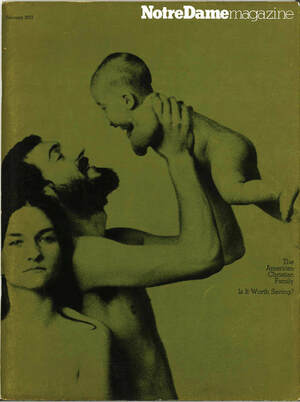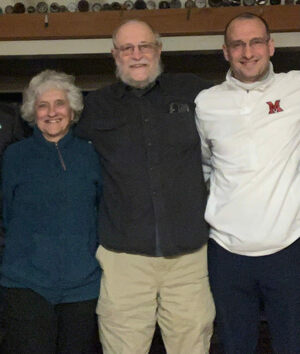
It was a daring image, even by the shifting cultural standards of the early 1970s.
A young couple, apparently naked but visible only from the waist up, with the husband holding their bare-bottomed infant son in the air.
It appeared on the front cover of the February 1973 Notre Dame Magazine, with this question: “The American Christian Family: Is It Worth Saving?”
The cover image shows Jim Killy ’73MFA, his wife, Sue, and their infant son Jude.
What became of that family? Where are they now?
In a recent interview, Jim and Sue Killy reflected on that photo of 49 years ago and where life has taken them since. The couple, both 76 and semi-retired, live in Oxford, Ohio.
In fall 1972, Jim — then a Notre Dame graduate student, young husband and father — was approached by professor Dick Stevens ’51, ’52M.A., a member of the art department faculty who taught photography courses. Stevens had agreed to shoot a cover photo for an upcoming Notre Dame Magazine.
“Dick had some ideas that revolved around having a family — a nude family, or what appeared to be a nude family — on the cover, with their child. And we just happened to have a baby,” Jim says.
Jude, born in September 1972, was just a couple of months old at the time.
Sue had reservations about a nude photo shoot. Then the photographer suggested hiring a model to pose in the wife/mother role. Sue immediately made up her mind. “I said, ‘There’s no way somebody else is gonna pose as my baby’s mother. I’ll do it,’” she recalls.
Stevens shot several rolls of film, with one image selected for the magazine cover. And yes, the Killys were totally nude for the studio photo shoot.
Jim explains: “They agreed that they would do kind of a waist up shot of me. On Susie, they did some photo magic and they kind of . . . ”
“Erased my breasts,” Sue finishes the sentence.
The photo was retouched to show the outline of Sue’s upper chest, without her breasts being visible in the final cover image.
“It wasn't anything that we were uncomfortable with at that point,” Jim says.
That issue of the magazine included nine essays by Notre Dame faculty, staff and a Ph.D. student offering their thoughts on the future of the American family. It was a turbulent era, amid the Vietnam War, rapidly changing cultural norms and young people often at odds with older generations.

The cover photo was planned to make a strong and hopeful statement about marriage and family life, editor Ronald R. Parent ’74M.A. wrote in a note to readers in the issue. Removing all extraneous items — even clothing — from the setting was intended to demonstrate the strength and beauty of the basic family unit.
Sue recalls being bemused by the question on the cover. “I thought the question that it posed was interesting because I didn't think that the Christian or Catholic family was in any trouble,” she says.
What was the public reaction?
The Killys had many friends, mostly associated with the art department, who thought the cover was artistic and elegant. The couple also took some good-natured ribbing about the image.
Reaction from readers was not quite as positive.
“If the cover depicts ‘the American Christian family,’ this country is in worse shape than I thought,” a 1954 alumnus wrote in a letter to the editor published in the next issue of the magazine.
“The question on the front cover, ‘The American Christian Family: Is It Worth Saving?’ and the picture, lead me to this comment, yes, the Christian family is worth saving but I cannot say the same for Notre Dame Magazine,” a 1950 alumnus wrote.
Like baby Jude, Notre Dame Magazine was in its infancy. It survived and has flourished in the years since. The Killy family image was included in a photo gallery of Notre Dame Magazine covers (216 of them so far) posted online this year to mark the magazine’s 50th anniversary.
Jim is an art professor emeritus at Miami University, where he specialized in sculpture. He stepped down from the full-time faculty in 2008 after 32 years.
Jim and Sue both grew up in Toledo, Ohio. They met at age 16 when they were introduced by a mutual friend, and married in 1968. The couple arrived in South Bend in August 1971 when Jim enrolled in the art department’s graduate program. The family already included one son, Quinn, and Jude was born a year later.
Jim had earned a bachelor’s degree in fine arts from the Columbus (Ohio) College of Art and Design. He was a military veteran, having just completed two years of service in the U.S. Army.
During their Notre Dame years, the Killys lived at University Village — the married student apartment complex that stood north of campus. They helped tend a community garden and developed close friendships with other married student couples, many of whom also had young children.
“It was great. We took turns having potlucks, babysitting for one another and taking walks with all the kids around campus,” Sue says.
“We loved it,” Jim says.
Jude Killy will turn 50 this year. He, his wife and their two children also live in Oxford, where he is Miami University’s deputy director of athletics and chief of staff.
After leaving Notre Dame, the Killys had two daughters: Sarah and Clare. From their four children, the couple now have eight grandchildren.
The Killys look back happily on their lives together, their time at Notre Dame and the joys of raising their family. They have no regrets.
These days, Jim teaches occasional workshops and continues to produce artwork in his home studio. He also handcrafts and sells bamboo fly fishing rods. Sue, a former K-12 educator, works part-time in retail. They’re both in good health and are active volunteers in their community.
“Our life has been just wonderful,” Jim says. “We couldn’t ask for more.”
Margaret Fosmoe is an associate editor of this magazine. Contact her at mfosmoe@nd.edu or @mfosmoe.